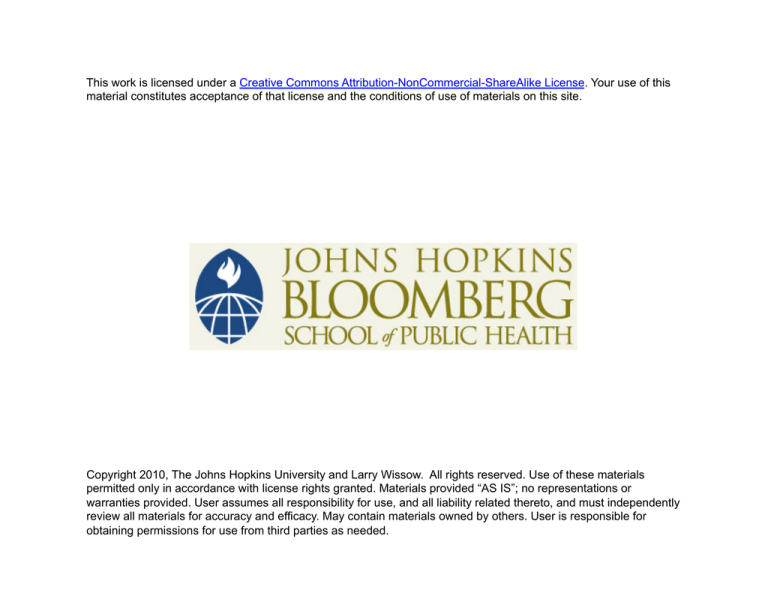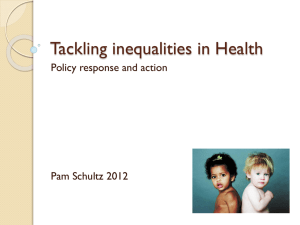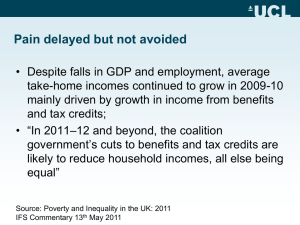
This work is licensed under a Creative Commons Attribution-NonCommercial-ShareAlike License. Your use of this
material constitutes acceptance of that license and the conditions of use of materials on this site.
Copyright 2010, The Johns Hopkins University and Larry Wissow. All rights reserved. Use of these materials
permitted only in accordance with license rights granted. Materials provided “AS IS”; no representations or
warranties provided. User assumes all responsibility for use, and all liability related thereto, and must independently
review all materials for accuracy and efficacy. May contain materials owned by others. User is responsible for
obtaining permissions for use from third parties as needed.
Socio-­‐economic Status (SES), Poverty, and Income Inequality How do these concepts relate to the health of popula?ons? Modified from: Berkman LF, Glass T, BrisseJe I, Seeman TE. From social integra?on to health: Durkheim in the new millennium. Soc Sci Med. 2000 Sep;51(6):843-­‐57 Class Objec?ves • Develop an understanding of key concepts including socio-­‐economic status (SES) and income inequality • Become familiar with key measurements: – Poverty level – Gini coefficient • Examine data linking SES and income inequality to health status Major theorists • Emile Durkheim – “The Division of Labor in Society” – Reflects higher levels of complexity, func?onality for the society • Karl Marx – Rela?onship to means of produc?on – Two key classes – owners, workers – Focus on issues of power, control, ownership Major theorists Max Weber – Mul?ple axes • Class (economic) – Defined by economic “life-­‐chances”: what can you do or hope for – Stra?fied according to rela?ons to produc?on and acquisi?on of goods • Status (social) – Amorphous communi?es ?ed by “honor” – Stra?fied according to principles of consump*on of goods as represented by “styles of life” • “Party” (poli?cal/power) – May be ephemeral or enduring – Defined by ability to organize communally towards a given goal Pierre Bourdieu’s socio-­‐cultural strata High cultural capital
Low cultural capital
High economic capital
A
B
Low economic capital
C
D
-­‐ Economic capital (income, wealth) -­‐ Cultural capital (accumulated knowledge of ar?s?c and intellectual tradi?ons of society) Most commonly used in public health studies 1) Level of income or accrued wealth (15%) 2) Type of occupa?on (22%) 3) Level of educa?on (45%) Percents refer to share of studies in American Journal of Epidemiology from 1982-­‐1985 using this variable as proxy for SES (Source: Kaplan and Keil 1993) UK classifica?on Brazilian Economic Classification Criteria (from www.abep.org)
Brazilian SES saying?! Adapted from “Fair Societies, Healthy Lives,” The Marmot Group, 2010. Available at: http://www.marmotreview.org/
AssetLibrary/pdfs/Reports/FairSocietyHealthyLives.pdf
UK life expectancy versus occupa?onal class U.S. Mortality vs educa?on Source: U.S. Department of Health and Human Services. 1998. “Health, United States, 1998; with Socioeconomic Status and Health Chartbook”
Least
deprived
Deprivation
twentieths
Most
deprived
Adapted from “Fair Societies, Healthy Lives,” The Marmot Group, 2010. Available at: http://www.marmotreview.org/
AssetLibrary/pdfs/Reports/FairSocietyHealthyLives.pdf
Least
deprived
Deprivation
twentieths
Most
deprived
Adapted from “Fair Societies, Healthy Lives,” The Marmot Group, 2010. Available at: http://www.marmotreview.org/
AssetLibrary/pdfs/Reports/FairSocietyHealthyLives.pdf
22 months
42 months
62 months
118
months
Adapted from Fair Society, Healthy Lives: Strategic review of health inequalities in England post-2010. February,
2010. www.ucl.ac.uk/marmotreview
Adapted from “Fair Societies, Healthy Lives,” The Marmot Group, 2010.
Available at: http://www.marmotreview.org/AssetLibrary/pdfs/Reports/FairSocietyHealthyLives.pdf.
Data source: 1958 National Child Development Study
Socioeconomic Status Birth weight by socioeconomic status, 2003-­‐4, UK Highest High middle Middle Low middle Lowest 1 2 3 4 Kilograms Socioeconomic Status Percentage of children whose mother suffered postnatal depression, by socioeconomic status, 2003-­‐4, UK Highest High middle Middle Low middle Lowest 0 5 10 15 20 Percentage Adapted from “Fair Societies, Healthy Lives,” The Marmot Group, 2010.
Available at: http://www.marmotreview.org/AssetLibrary/pdfs/Reports/FairSocietyHealthyLives.pdf.
25 Adapted from “Fair Societies, Healthy Lives,” The Marmot Group, 2010.
Available at: http://www.marmotreview.org/AssetLibrary/pdfs/Reports/FairSocietyHealthyLives.pdf.
Percentage of children 10-14 exposed to movie violence
Parent Educa4on N Percent RR 1987 35.11 Reference Some college, voca?onal/technical, or 1904 Associates degree 53.53 1.81 (1.48-­‐2.21) High school graduate or less 61.81 2.86 (2.34-­‐3.49) Bachelors, graduate, or professional degree 2615 Adapted from Worth KA, et al. Pediatrics 2008;122:306-­‐312 Development quotients of growth-retarded infants in stimulation/nutrition study,
Jamaica. WHO, 2008
Defini?ons – absolute poverty Cri?que of Orshansky method Alterna?ve calcula?ons of 2001-­‐2 poverty rates using NAS 1995 op?ons. Source: US Census: hJp://www.census.gov/hhes/www/poverty/
poverty02/table7.pdf MIS: medical out-­‐of-­‐pocket subtracted from income MIT: medical out-­‐of-­‐pocket included in threshold CMB – combined the two above Source: Wikimedia Commons. http://commons.wikimedia.org/wiki/File:Lorenz-curve1.png. Creative Commons BY-SA.
* 0 = perfect equality; 1= perfect inequality. Source: ADB. Adapted from The Economist, August 11, 2007.
Worsening maldistribu?on of income • The income gap between those in the top 5% of US income distribu?on and those in the boJom 40% has been steadily increasing since in the early 1980s. Source: ADB. Adapted from The Economist, August 11, 2007.
Relative poverty and health
• Among European countries, the percentage
of overall wealth owned by the poorest 70%
of the population is positively correlated
with health status.
• In US, increase in Gini coefficient (0-1) of
0.1 corresponds to 46% increase in
preventable deaths (Ronzio)
Proposed mechanisms rela?ng absolute income to health • Reduced sense of control over life events – At work and home • Demand overload – Lack of resources to cope with demands – Increased “demands” in the form of less op?mal environment • Reduced social par?cipa?on/less access to social resources (Kim 2008)
Adapted from “Fair Societies, Healthy Lives,” The Marmot Group, 2010. Data Source: Whitehall II study.
“Social neuroscience” • Epigene?cs: environmental influences on gene expression • Cri?cal periods (?) for early nurturing that – Permanently (?) set level at which glucocor?coid receptor gene is expressed • Varies response to stress – Permanently (?) set level at which oxytocin receptor gene expressed • Varies nurturing and other affilia?ve behaviors Adapted from “Fair Societies, Healthy Lives,” The Marmot Group, 2010. Data Source: Whitehall II study.
Social dis?nc?on • Groups dis?nguish themselves through differen?al consump?on – Partly economic but also symbolic (Bourdieu) • Concept of “posi?onal goods” Impact of posi?onal spending -­‐ 1 Gas Grills Then and Now (Frank)
1989 Sunbeam, $90
Viking Professional, $5,000.
Impact of posi?onal spending -­‐ 2 Personal Savings Rate Decrease • Low savings is a serious problem • Decline in savings rate has tracked increase in income inequality Impact of posi?onal spending -­‐ 3 • Reduced intergenera?onal mobility from lack of resources for children – What are the opportuni?es for subsequent genera?ons to improve their SES (and thus their health)? – What resources for healthy development are universally provided? – What resources are dependent on family income? Diffusion of “dis?nc?on” • Upper SES takes on new bad habit • Habit loses dis?nc?on as: – Learn more about risks – Have greater resources to tolerate/treat withdrawal – Mass marke?ng and copying make habit less dis?nc?ve Diffusion of “dis?nc?on” • Lower SES gets stuck with habit – Upper SES is making a profit • “Habit” is aggressively marketed – Lower SES has fewer resources to treat/tolerate withdrawal – Habit is “embedded” in group that has least social mobility SES as determinant of social ?es • SES constrains social ?es – Diverging values – Lack of resources that permit mobility • Poor public transit • Lack of public educa?on • Deliberate segrega?on Christakis NEJM 2008;358:2249 [Colored bars are successive waves of observa?on] Christakis NEJM 2008;358:2249 [Colored bars are successive waves of observa?on] Coming up • Lab session – Whitehall II data on control and CHD and gender • Next two classes – Social networks – Social support – Social cap?al






